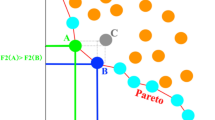Abstract
Pareto-optimality conditions are crucial when dealing with classic multi-objective optimization problems. Extensions of these conditions to the fuzzy domain have been discussed and addressed in recent literature. This work presents a novel approach based on the definition of a fuzzily ordered set with a view to generating the necessary conditions for the Pareto-optimality of candidate solutions in the fuzzy domain. Making use of the conditions generated, one can characterize fuzzy efficient solutions by means of carefully chosen mono-objective problems and Karush-Kuhn-Tucker conditions to fuzzy non-dominated solutions. The uncertainties are inserted into the formulation of the studied fuzzy multi-objective optimization problem by means of fuzzy coefficients in the objective function. Some numerical examples are analytically solved to illustrate the efficiency of the proposed approach.
Similar content being viewed by others
References
Ammar E. E. (2008) On solutions of fuzzy random multiobjective quadratic programming with application in portfolio problem. Information Sciences 178: 468–484
Campos L., Verdegay J. L. (1989) Linear programming problems and ranking of fuzzy numbers. Fuzzy Sets and Systems 32: 1–11
Cantão, L. A. P., & Yamakami, A. (2003). Nonlinear programming with fuzzy parameters: Theory and applications. In International conference on computational intelligence for modelling, control and automation, CIMCA.
Chankong, V., & Haimes, Y. Y. (1983). Multiobjective decision making: Theory and methodology, Vol. 8 of North Hollando series in system science and engineering. North Holland, New York, USA.
Dubois D., Prade H. (1980) Fuzzy sets and systems: Theory and application. Academic Press, San Diego, USA
Dubois D., Prade H. (1983) Ranking fuzzy numbers in the setting of possibility theory. Information Sciences 30(3): 183–224
Farina, M., & Amato, P. (2003). Fuzzy optimality and evolutionary multiobjective optimization. In Second international conference evolutionary multi-criterion optimization, Faro, Portugal.
Farina M., Amato P. (2004) A fuzzy definition of”optimalit” for many-criteria optimization problems. IEEE Transactions on Systems, Man, and Cybernetics-Part A: Systems and Humans 34(3): 315–326
Hussein M. L., Abdel Aaty Maaty M. (1997) The stability notions for fuzzy nonlinear programming problem. Fuzzy Sets and Systems 85: 319–323
Jiménez F., Cadenas J. M., Sánchez G., Gómez-skarmeta A. F., Verdegay J. L. (2006) Multi-objective evolutionary computation and fuzzy optimization. International Journal of Approximate Reasoning 43: 59–75
Kaufmann A., Gupta M. M. (1984) Introduction to fuzzy arithmetic: Theory and applications. Van Nostrand Reinhold, New York, USA
Klir G. J., Yuan B. (1995) Fuzzy sets and fuzzy logic: Theory and applications. Prentice Hall, New Jersey, USA
Köppen, M., Franke, K., Nickolay, B. (2003). Fuzzy-pareto-pominance driven multiobjective genetic algorithm. In 10th IFSA world congress, Istanbul, Turkey.
Köppen, M., Garcia, R. V., Nickolay, B. (2005). Fuzzy-pareto-dominance and its application in evolutionary multi-objective optimization. In Evolutionary multi-criterion optimization, third international conference, Guanajuato, Mexico.
Kuwano, H. (2000). Inverse problems in fuzzy multiobjective linear programming. In Second international conference on knowledge-based intelligent eletronic systems, Adelaide, Australia.
Pareto V. (1897) Cours d’economique politique (Vol. 1). Macmillan, Paris, FR
Pareto V. (1897) Le cours d’economique politique (Vol. 2). Macmillan, London, UK
Pedrycs W., Gomide F. (1998) An introduction of fuzzy sets: Analisys and design. MIT press, Cambridge, MA
Sakawa M. (1993) Fuzzy sets and interactive multiobjective optimization. Plenum Press, New York, USA
Zadeh L. A. (1965) Fuzzy sets. Information and Control 8: 338–353
Zadeh L. A. (1978) Fuzzy sets as a basis for a theory of possibility. Fuzzy Sets and Systems 1(1): 3–28
Zadeh L. A. (2008) Is there a need for fuzzy logic?. Information Sciences 178: 2751–2779
Zimmermann H.-J. (1996) Fuzzy set theory and its applications (3rd ed.). Kluwer Academic Publishers, Massachusetts, USA
Author information
Authors and Affiliations
Corresponding author
Rights and permissions
About this article
Cite this article
Silva, R.C., Yamakami, A. The use of possibility theory in the definition of fuzzy Pareto-optimality. Fuzzy Optim Decis Making 10, 11–30 (2011). https://doi.org/10.1007/s10700-010-9092-z
Published:
Issue Date:
DOI: https://doi.org/10.1007/s10700-010-9092-z




